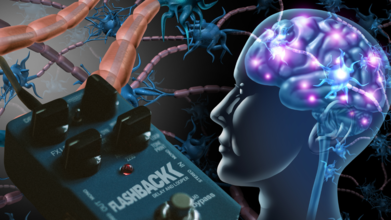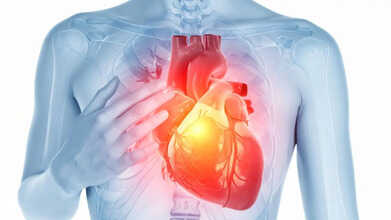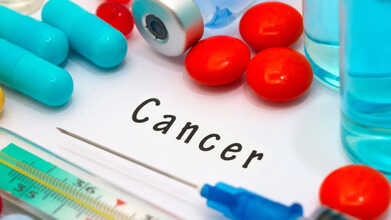- Health Conditions A-Z
- Health & Wellness
- Nutrition
- Fitness
- Health News
- Ayurveda
- Videos
- Medicine A-Z
- Parenting
7 Minutes after Death: The Science Behind What Happens To Your Brain After You Die

Credits: Canva
What happens in the brain at the moment of death has fascinated doctors, philosophers, and ordinary people for centuries. Myths and religious traditions have long spoken of a “life review,” where your past flashes before your eyes. Modern science, for the first time, is beginning to catch glimpses of what really unfolds in the final minutes after the heart stops.
A widely discussed idea is that the brain may continue working for about seven minutes after death, potentially giving rise to vivid flashes of memory and awareness. Recent studies suggest this may not be just folklore.
Some researchers have recorded brief surges of organized brain activity in people who were close to death, including patterns linked with memory, perception, and dreaming. These findings have strengthened the idea that the brain does not shut down all at once.
Also Read: Can TikTok’s ‘Potato Bed’ Hack Really Help You Sleep Better? Experts Are Not So Sure
Recording the Dying Brain
In 2022, doctors in Canada made a startling discovery. They were monitoring an 87-year-old patient with epilepsy when he suddenly suffered cardiac arrest. As his heart stopped, the electroencephalogram (EEG) kept recording his brain activity. What they saw was astonishing: rhythmic brain waves that resembled those seen during memory recall, dreaming, or meditation.
The researchers noted surges in gamma oscillations, which are linked to conscious processing, learning, and memory retrieval. It was as if the man’s brain was playing back moments of his life in a final act of reflection. This provided the first direct evidence that the dying brain may remain active, even organized, after the heart has stopped.
Also Read: Why Is This Psychologist Warning Against Benzodiazepines For Anxiety Treatment?
Seven Minutes of Life
The “seven minutes of life” theory emerged from similar findings. When the heart ceases to beat, blood flow to the brain stops, but neurons do not die immediately. Instead, they enter a state of frantic activity as they are starved of oxygen. During this short window, electrical surges ripple across the cortex, creating what some scientists describe as a last burst of consciousness .
Some neurologists believe this window could be responsible for the life-flashing-before-your-eyes phenomenon reported in near-death experiences. Memories may be triggered by abnormal synchronization of neurons, creating vivid, movie-like recollections.
Near-Death Experiences and Life Reviews
The connection between this brain activity and near-death experiences (NDEs) is striking. Studies of cardiac arrest survivors show many report floating above their bodies, seeing tunnels of light, or meeting deceased loved ones. Others describe a panoramic replay of their life events, sometimes accompanied by feelings of peace and detachment.
Dr. Sam Parnia’s large-scale AWARE studies monitored hundreds of patients across multiple hospitals during cardiac arrest. While most did not survive, some who were revived reported precise details of events in the room while they were clinically dead, as well as intense memory flashbacks. These reports align with the idea that the brain, far from shutting down instantly, lingers in a state of heightened, unusual activity.
Also Read: Is The ‘Frankenstein’ COVID Variant The Most Vaccine-Resistant Strain Yet?
The Brain’s Last Burst
Neuroscientists suggest that this “last burst” could be explained by the physiology of dying neurons. As oxygen levels plummet, neurotransmitters like glutamate flood the brain. This overstimulates neurons, causing them to fire in abnormal, synchronized ways. Gamma oscillations may peak during this time, briefly sustaining complex conscious experiences.
In animal studies, rats that suffered cardiac arrest showed spikes of coherent brain activity within 30 seconds of death. Human data now confirm similar patterns. Although brief, this activity may be enough to produce vivid subjective experiences.
Consciousness After Death: Science or Spirituality?
These findings raise profound questions. If the brain continues to generate conscious-like activity minutes after death, does this blur the boundary between life and death? Is the “life review” a final, natural brain function, or does it hint at something beyond?
While many scientists caution against overinterpreting the results, others see the possibility of bridging neuroscience and spirituality. The universality of near-death reports across cultures suggests there may be common biological mechanisms at work, yet their meaning remains open to interpretation.
Some traditions describe this as the soul’s transition, while neurologists see it as a natural byproduct of oxygen-starved neurons. Either way, the dying brain appears far from silent.
Also Read: What Health Conditions Has President Donald Trump Been Diagnosed With?
Redefining Death
Traditionally, death was declared when the heart stopped beating. Today, medicine recognizes that death is a process rather than an instant. Brain activity may persist for minutes, and in rare cases of resuscitation, patients return with memories of those moments. This challenges both how we define death and how long doctors should wait before making the declaration.
Modern guidelines already recommend observing a patient for several minutes after cardiac arrest before pronouncing death. Discoveries about lingering brain activity add further weight to this caution.
Winter Pollution Could Trigger Dangerous Chest Pain, Cardiologist Warns

Credits: Canva
For decades, cardiologists have noticed a clear seasonal trend. Heart attacks tend to rise during the winter months. Patients who already have heart conditions often see their health decline in the cold season, requiring more frequent and longer hospital stays. As winter approaches, pollution levels spike dramatically, making breathing more difficult, and for good reason.
Multiple factors combine to create this seasonal risk. We spoke to Dr. Vikash Goyal, Senior Cardiologist at Paras Health, Gurugram, to understand why chest pain becomes more common in winters.
Why Does Winter Trigger More Heart Risks?
Traditionally, this increase in heart-related issues has been linked to the body’s response to cold temperatures. Winter causes blood vessels to constrict and can lead to higher blood pressure, while reduced sweating may cause salt to build up in the body.
Less physical activity, along with a tendency to eat heavier, richer foods, adds to weight gain and raises blood sugar and cholesterol. Together, these factors increase the workload on the cardiovascular system, contributing to the rise in cardiac events during the winter months.
How Does Winter Pollution Trigger Chest Pain?
One constant in North Indian winters is a sharp rise in air pollution that comes alongside dropping temperatures. As the air cools and circulation slows, a thick layer of smog lingers over many cities. This pollution is a mix of vehicle emissions, construction dust, industrial smoke, and seasonal crop stubble burning. The simultaneous rise of air pollution and winter cardiac hospitalizations is too pronounced to ignore.
Dr. Vikash Goyal explained that air pollution has a significant but often overlooked effect on heart health. The heart relies on clear blood flow to support all major organs. When polluted air enters the lungs, tiny particles enter the bloodstream, triggering inflammation throughout the body. This narrows and stiffens blood vessels, forcing the heart to work harder while reducing oxygen supply to vital organs like the brain and kidneys.
He said, “This can lead to headaches, fatigue, dizziness, or worsening kidney function. During winter, the combination of cold temperatures and trapped smog thickens the blood and raises blood pressure, putting extra strain on the heart.” This explains why chest pain, breathlessness, and other cardiac issues increase during winter pollution season. Protecting yourself from polluted air isn’t just about lungs—it’s about safeguarding your whole cardiovascular system.
How Do PM2.5 Particles Harm The Cardiovascular System?
According to the World Health Organization, PM2.5 particles entering the bloodstream can cause multiple harmful effects on the heart. They trigger inflammation, destabilize cholesterol plaques, and increase the risk of plaque rupture, a common cause of heart attacks. They also create oxidative stress, producing free radicals that damage blood vessels and speed up atherosclerosis. Additionally, PM2.5 thickens the blood and makes platelets stickier, raising the chance of clots forming in blood vessels.
How To Protect Your Heart During Winter Pollution?
To reduce the impact of winter pollution on your heart, limit outdoor exposure on high-pollution days, wear N95 or N99 masks when going out, and use air purifiers and humidifiers indoors. Stay hydrated, eat foods rich in antioxidants, and keep an eye on your health.
If you notice persistent chest pain, tightness, or other concerning symptoms, seek medical help immediately.
Four Medical Checks That Can Spot Cancer Before Symptoms Appear

Credits: Canva
Receiving a cancer diagnosis is scary, but what often causes greater harm is the delay in finding the disease and starting treatment. Many patients visit doctors only when symptoms become too obvious to ignore, by which time the illness has already advanced and is far harder to control. In most cases, cancer is caught late not because it hides well, but because people skip routine screenings.
In an Instagram video shared on November 6, Dr Jayesh Sharma, consultant surgical oncologist at ITSA Hospitals, spoke about four key tests that can help detect cancer early and reduce the number of late-stage cases.
4 Tests That Help Catch Cancer Early
Dr Sharma explained that there are four screenings everyone should consider. He noted that these tests can help identify cancer at the very first stage, when abnormal cells have formed but have not yet begun to spread. Detecting it at this point allows doctors to remove the cells completely, giving patients an excellent chance of recovery.
Mammography
Dr Sharma advised getting a mammogram once around the age of 40. He mentioned that while yearly tests are often suggested, most people do well with a screening every two years.
Cervical Cancer Screening
Cervical cancer remains one of the most common cancers in women. According to Dr Sharma, the Pap smear is a reliable way to catch early changes in cervical cells, even before symptoms appear.
Stool Test
He also recommended a stool test as a simple way to look for signs of stomach cancer. The earliest sign of trouble in the stomach is often hidden bleeding, which can be picked up through this test.
Chest CT Scan
For people who have been heavy smokers over many years, Dr Sharma suggested a chest CT scan. This group faces a higher chance of lung cancer, and a scan can help identify changes in the lungs at an early stage.
Symptoms Of Cancer
Warning signs of cancer can appear in many ways, and the symptoms usually depend on which part of the body is involved.
Some broad symptoms that may point to cancer, though they can occur in many other conditions as well, as per Mayo Clinic include:
- Fatigue that does not improve
- A lump or thickened area you can feel beneath the skin
- Unexpected weight loss or gain
- Changes in the skin, such as darkening, redness, yellowing, slow-healing sores, or new changes in moles
- Altered bowel or bladder habits
- A cough that lingers or ongoing breathing trouble
- Difficulty swallowing food
- A rough or hoarse voice
- Regular indigestion or discomfort after meals
- Ongoing, unexplained joint or muscle pain
- Recurring fevers or night sweats without a clear cause
- Bleeding or bruising without explanation
When To Seek Medical Advice
You should contact your doctor if any symptom continues for a long time or gives you reason to worry.
If you feel fine but are anxious about your cancer risk, speak with your doctor about it. They can guide you on the screening tests or checks that may be suitable for you
Can Egg Freezing Reduce Your Egg Quantity? Doctor Explains

Credits: Canva
Recent data from the Human Fertilisation and Embryology Authority show a sharp rise in the number of women opting for egg-freezing. Yet the subject remains clouded by many misunderstandings. The decision itself is not simple. It involves emotional questions, significant costs and the physical demands of treatment. One common misunderstanding is the belief that egg freezing can harm egg quality, when the procedure does not lower the inherent quality of the eggs you already have.
We got in touch with Dr Shaweez Faizi, Fertility Specialist, Nova IVF Fertility, Mangalore, who told us more about the same.
What Is Egg Freezing?
Egg freezing, also called oocyte cryopreservation, is a fertility option in which a woman’s eggs are collected, frozen, and kept for future use. The steps include taking hormones to help the ovaries produce multiple mature eggs, retrieving those eggs through a short clinical procedure, and freezing them through a rapid cooling method known as vitrification.
As per Healthline, the frozen eggs are then stored in liquid nitrogen. When pregnancy is planned later, the eggs are thawed, fertilized in a laboratory, and the embryo is transferred to the uterus.
How Egg-Freezing Works?
The journey begins with roughly 8 to 12 days of hormonal tablets and injections that help several follicles grow at once. Dr Shaweez Faizi told us that doctors then use an ultrasound-guided needle to retrieve the mature eggs under light anaesthesia. The eggs are preserved through vitrification. The medication does not pull eggs from future years. It acts only on that month’s cohort, which is why medical bodies consider the procedure safe and ethically sound.
Can Egg Freezing Lower Your Egg Quantity?
Dr Shaweez Faizi told us that egg-freezing does not drain your ovarian reserve for life. The process collects only the group of eggs that your body was already preparing to release in that month. Some women notice a short-term dip in AMH after the procedure, but this usually settles with time. The stored supply inside the ovaries remains unchanged.
For those unversed, AMH, or Anti-Müllerian Hormone, is commonly used to assess ovarian reserve, meaning the approximate number of eggs still present in a woman’s ovaries.
Anti-Müllerian Hormone and Reserve
AMH is often treated as a marker of ovarian reserve, though it naturally varies. Studies show that a small number of women experience a temporary fall in AMH after stimulation, followed by a return to baseline. Specialists usually advise repeating the AMH test a few months after retrieval to get an accurate picture.
Egg Freezing Success Rates
Age at the time of freezing and the number of eggs stored have the strongest influence on outcomes. Global data suggest that women under 38 who freeze about 20 eggs tend to have higher chances of a future live birth. Older women usually retrieve fewer eggs per cycle, and success rates decline. Indian clinics report a wide range of live-birth outcomes, depending on age and the number of usable eggs.
People with low AMH or diminished reserve will have fewer eggs from the start. The issue lies in the baseline biology, not in the freezing itself. Those who have had ovarian surgery, such as endometrioma removal, may have reduced reserve due to the operation and should plan their timing carefully.
Women facing chemotherapy or serious medical treatment should consult both oncologists and fertility specialists. The Indian Fertility Society recently issued guidance on handling low ovarian response and preservation choices.
Practical Steps For Those Considering Egg Freezing
Dr Shaweez Faizi shared a few practical steps for women considering egg freezing:
• Start with basic tests such as AMH, AFC and a hormonal panel.
• Ask detailed questions about expected egg yield for your age, the number of cycles you may need, and the clinic’s real success figures. Advertising often paints a brighter picture than the data.
• Plan financially for medication, scans, retrieval, freezing and long-term storage.
• Keep age in mind, as younger eggs are more likely to develop into healthy embryos.
• Choose established centres that follow national and international practice standards.
Egg-freezing is a recognised and safe method to preserve fertility options, but it is not a guaranteed path to pregnancy.
Costs, success rates and the number of cycles needed vary widely. As the service becomes more accessible in India’s metropolitan centres, careful counselling and realistic planning remain essential before you decide.
© 2024 Bennett, Coleman & Company Limited

